
AI and the Retail Marketer’s Future
How AI transforms strategy and processes, driving the adoption of Positionless Marketing
Exclusive Forrester Report on AI in Marketing
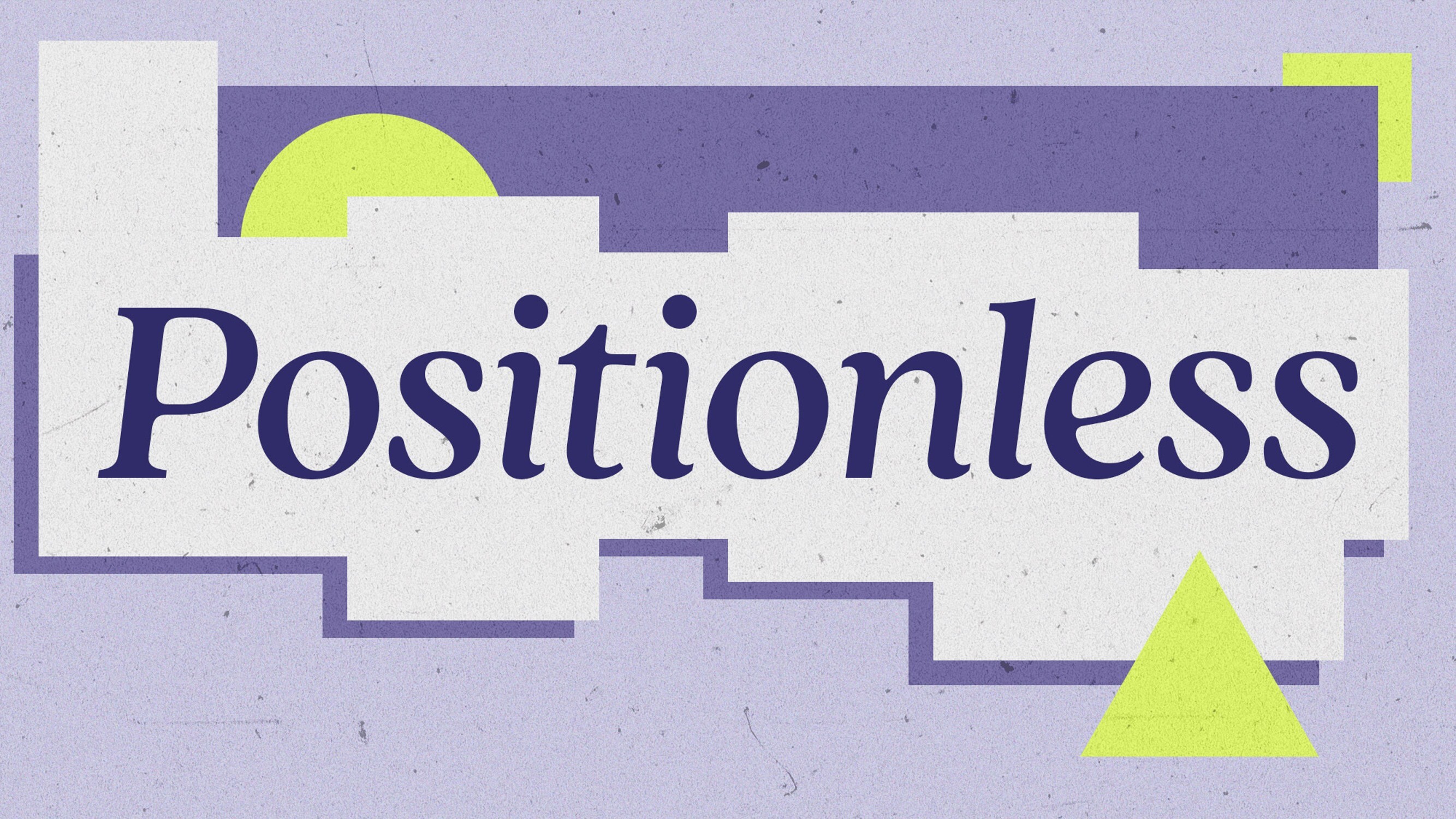
For the better part of this decade, mobile has reigned supreme in social gaming, and the trend is on the rise. Recent research suggests that the mobile share of all social casino games on both platforms is 20%-98%, with an average of 65% mobile versus 35% Web. This average is growing in favor of mobile at an annual pace of 1.5%.
But what are mobile players like, and how do they differ from Web players? We intuit that mobile players are more engaged and proactive, but how much more intense are they in contrast to Web players? And what characterizes multi-platform players—those engaging with the game on both mobile and Web?
To answer these questions, we conducted some thorough industry research, leveraging data from tens of millions of players across dozens of social casino games. We used data generated only by those players who initiated a first game session (ignoring those who downloaded a game, but never played it).1 The numbers paint a vivid picture of social gamer personas, tendencies and value.
The overwhelming majority of social gamers have a clear-cut preference for one platform: 96% limit their gaming experience to either mobile or Web. The remaining 4% play on both platforms. Of the 96% who are single-platform players, the average mobile/Web ratio is 65%/35%.
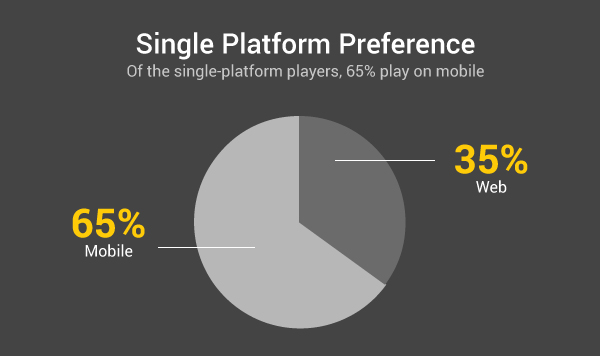
Our research shows that mobile players exhibit faster progress across all metrics. They convert faster into paying customers, they make their second payment—as well as subsequent payments—faster, they play more often and they initiate more sessions each time they play. Across all metrics, they are like Web players on fast-forward! Having their platform (mobile device) with them at all times surely helps, as well as the current tendency to check their device 200 times daily, on average.2 As opposed to the more sedentary Web players, mobile players like to play on the go, whenever there’s time to kill or the luxury to sit back and be entertained. The result is more exposure to the game, greater engagement and more frequent payment routines.
While there are no consistent differences in conversion rates between mobile and Web players, conversion speed is almost twice as high on mobile: mobile gamers convert 1.9X faster than Web players. While the average conversion period on mobile is 30 days (with a median of eight days), Web gamers will make their first payment only 52 days after their first session (with a median of 21 days). (It’s interesting to note that for both platforms, same-day conversion occurs among 7%-15% of all players.)
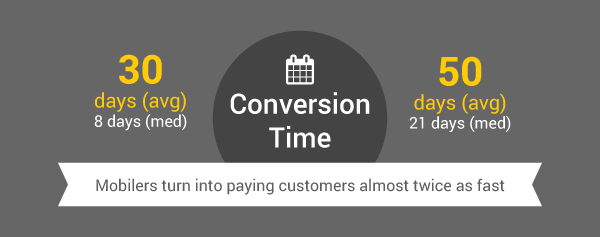
Mobile players also tend to make their second payment considerably sooner. While there is no significant difference in the first-to-second-payment rate (both mobile and Web players average 52%), paying mobile players make their second payment 1.5X sooner than Web players. On average, the time elapsed between first and second payments is 18 days for mobile players (with a median of five days), and 27 days for Web players (with a median of ten days).
After reaching the second-payment milestone, mobile players continue to make more frequent payments. While there is no consistent difference in payment amounts between the two platforms (in some games, mobile trumps and in others, Web), mobile players exhibit 1.4X more payment days than Web players (i.e., distinct days on which one or more payments are made). In terms of time between payments, we observed a transaction every ten days for mobile gamers, compared to every 14 days for Web gamers.
Mobile players also play more often, with more sessions occurring more rapidly. They boast 1.6X more game-play days than Web players, playing every 4.2 days during their activity period, versus every 6.7 days for Web players. For every one of those playing days, mobile players register 1.4X more game sessions than Web players. So, not only do mobile gamers have more active play days, they play more on each of those days.
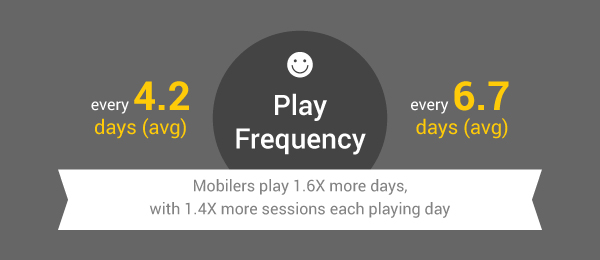
In terms of retention rates, there is no correlation with a player’s platform preference; retention rates vary significantly between games across both mobile and Web.
What about those gamers without a distinct preference for one particular platform? Among the games we examined, we found that between 0.5% and 9% of players played on both platforms, with an average of 4%. These numbers indicate that the great opportunity lies with these multi-platform players. Multi-platform players aren’t the ones just killing time with your game—they’re the ones making time to play, whenever and wherever they can: on their phone while commuting, on the office desktop when they need a break, at home in the evening and anywhere in between. Multi-platform players tend to be your most valuable customers.
Among multi-platform players, the percentage of players who converted to paying customers is a staggering 3.9X higher than the conversion rate of single-platform players: 8.8% (!) versus 2.2% for single-platform players.
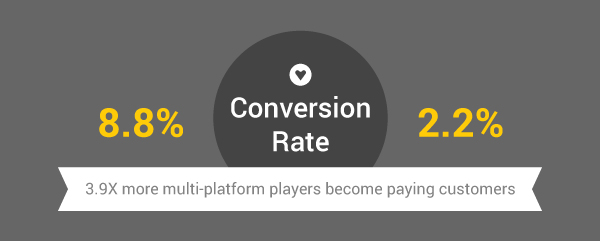
Multi-platform players are also 20% more likely to ever make a second payment, thus demonstrating a substantially higher LTV: 63% of multi-platform players make a second payment versus 52% among single-platform players. And while there isn’t a statistically significant difference between the payment amounts made by mobile and Web gamers, the average payment made by multi-platform players is 10% higher than that of single-platform players.
No one can dispute the fact that mobile is on the rise. In fact, many companies breaking into the gaming industry today design for mobile only, treating the Web as redundant. Our data backs up the supposition that things happen faster on mobile in the world of social gaming. However, it’s worth noting that mobile doesn’t surpass the Web in some significant KPIs, including payment amounts, conversion rates and retention rates. So, while social gaming publishers enjoy greater immersion among mobile gamers, there’s still a lot of value in those players who remain loyal to gaming on the Web.
Our data shows that social gaming’s best customers are neither on the Web nor on mobile exclusively—they’re the double-delight multi-platform players. These findings suggest that it may be worthwhile investing in marketing campaigns designed to push loyal single-platform players into the other platform. Giving them a significant incentive to play your game on the other platform may help them cross the chasm from single- to multi-platform players and become the fully immersed, totally engaged most-valuable players of your games.
Our CEO, Pini Yakuel, presented these findings at a Casual Connect event. Watch it here:
1The findings in this paper reflect only results that were consistent across all platforms, sites and apps. Single platform players were defined as users who played a minimum of 95% of their sessions on one platform.
2Source: Daily Mail
Exclusive Forrester Report on AI in Marketing
In this proprietary Forrester report, learn how global marketers use AI and Positionless Marketing to streamline workflows and increase relevance.


Writers in the Optimove Team include marketing, R&D, product, data science, customer success, and technology experts who were instrumental in the creation of Positionless Marketing, a movement enabling marketers to do anything, and be everything.
Optimove’s leaders’ diverse expertise and real-world experience provide expert commentary and insight into proven and leading-edge marketing practices and trends.


